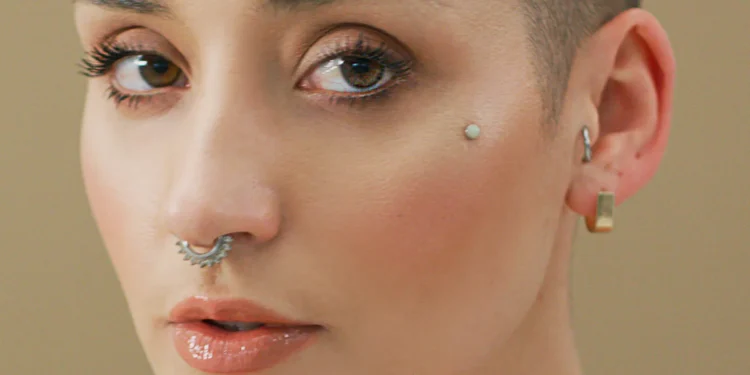Dermal anchor piercing is one of the most innovative ways to express individuality and style. If you’re searching for a unique body modification that stands out, this could be it. Unlike traditional piercings, dermal anchors offer versatility in placement and design. They create the illusion of jewelry floating on your skin. Curious about what goes into getting a dermal anchor? Let’s dive deeper into this captivating trend!
Table of Contents
Dermal Anchor Piercing Blog Article Outline
Dermal anchors are becoming increasingly popular in the world of body modification. They provide a unique way to showcase personal style while allowing for creative placements on various parts of the body.
These piercings differ from standard methods, offering both aesthetic appeal and versatility. With an understanding of their procedure, aftercare, jewelry options, and potential risks, you can make informed decisions about your next piercing adventure.
1. Introduction to Dermal Anchor Piercing
Dermal anchor piercing is a unique and eye-catching form of body art that allows for stunning designs on the skin. Unlike traditional piercings, this technique involves anchoring jewelry beneath the skin’s surface, creating an illusion of floating adornments.
This innovative style has gained popularity due to its versatility and aesthetic appeal. People often choose dermal anchors as a way to express individuality, making them a captivating addition to personal style.
2. Understanding Dermal Anchors
Dermal anchors are a unique type of body jewelry that allow for the placement of decorative pieces beneath the skin. Unlike traditional piercings, dermal anchors consist of an anchor that sits under the skin and a removable top piece.
These piercings offer versatility in design and placement, making them popular for various parts of the body. They provide a stunning aesthetic without visible backing, creating a seamless look that many enthusiasts adore.
2.1 What Are Dermal Anchors?
Dermal anchors are a unique form of body modification that allows jewelry to be anchored beneath the skin. Unlike traditional piercings, they consist of a small anchor-shaped piece implanted in the dermis layer, with only the decorative top visible.
This innovative technique provides flexibility in placement, allowing for creative designs on various parts of the body. Dermal anchors offer a stunning way to express individuality and style through body art.
2.2 Dermal Anchors vs. Surface Piercings
Dermal anchors and surface piercings are often confused, but they serve different purposes. Dermal anchors have a base that is implanted under the skin, allowing for a secure fit. This design reduces the risk of rejection compared to surface piercings.
Surface piercings consist of jewelry passing through two entry points on the skin’s surface. They can be more prone to irritation and migration due to their exposure, making dermal anchors generally safer for long-term wear.
3. Piercing Procedure and Aftercare
The dermal anchor piercing procedure begins with proper skin preparation and marking the desired spot. A professional piercer uses a specialized tool to create a small incision, inserting the anchor beneath the skin. This method allows for secure placement without visible jewelry on the surface.
Aftercare is crucial for healing. Keep the area clean and avoid touching it unnecessarily. Use saline solution or recommended aftercare products to promote healthy recovery while minimizing infection risks.
3.1 How Is a Dermal Anchor Piercing Done?
The dermal anchor piercing process begins with a thorough cleaning of the skin. The piercer then marks the desired location, ensuring precision for an aesthetically pleasing result.
Using a specialized needle, they create a small incision in the skin. The dermal anchor is gently inserted beneath the surface. This technique minimizes trauma and promotes healing while securing the jewelry snugly in place. It’s quick and generally well-tolerated by clients seeking unique body art.
3.2 Healing Process and Aftercare Tips
The healing process for a dermal anchor piercing typically takes about 6 to 12 months. During this time, it’s crucial to keep the area clean and avoid unnecessary irritation. Gentle cleansing with saline solution can help prevent infection.
Aftercare involves avoiding tight clothing over the piercing and steering clear of direct contact with dirty surfaces. Regularly check for signs of redness or swelling, as early detection is key in ensuring proper healing.
4. Jewelry Choices and Trends
When it comes to dermal anchor piercings, the jewelry options are diverse and exciting. From simple studs to elaborate designs, there’s something for every style. Popular choices include flat tops that sit snugly against the skin and gem-encrusted pieces that add a touch of sparkle.
Material selection is just as important; surgical steel, titanium, and gold are common favorites. As trends evolve, unique shapes and colorful stones continue to capture attention in the body art community.
4.1 Types of Jewelry Used for Dermal Piercings
When it comes to dermal piercings, the jewelry selection is vast. Most commonly, flat-backed studs are used. These designs ensure comfort and minimize movement during healing.
Another popular choice is decorative tops that can be swapped out for personalization. Options include gems, spikes, or unique shapes to express individual style. The right jewelry not only enhances aesthetics but also supports safe healing while adding a stylish touch to your look.
4.2 Material Options for Jewelry
When it comes to dermal anchor piercing jewelry, material selection is crucial for comfort and safety. Surgical stainless steel is a popular choice due to its durability and hypoallergenic properties. Titanium is another excellent option, known for being lightweight and resistant to tarnishing.
For those seeking something more unique, acrylic or glass pieces can add a vibrant touch. However, ensure they’re specifically designed for piercings to prevent irritation or infection.
4.3 Trending Dermal Jewelry Options
Fashion-forward individuals are embracing unique styles in dermal anchor jewelry. From geometric shapes to intricate designs, the options are endless. Popular choices include floral motifs and minimalist studs that blend seamlessly with various aesthetics.
Colorful gems and innovative materials add flair to these piercings, enhancing personal expression. Customizable pieces allow wearers to stand out while showcasing their individuality. With new trends emerging regularly, there’s always something fresh in the world of dermal anchors.
5. Cost and Longevity of Dermal Piercings
The cost of a dermal anchor piercing typically ranges from $50 to $100, depending on the studio’s location and reputation. This price usually includes the procedure and may cover initial jewelry.
Dermal piercings can last anywhere from several months to a few years with proper care. Factors like skin type, placement, and aftercare significantly influence their longevity. Regular maintenance is crucial for extending their life span effectively.
5.1 How Much Does a Dermal Anchor Piercing Cost?
The cost of a dermal anchor piercing typically ranges from $50 to $100. Prices can vary based on the location, tattoo studio reputation, and piercer experience. Some studios may include jewelry in the price while others charge separately.
Keep in mind that high-quality materials often come at a premium. Investing in reputable artists ensures not only safety but also stunning results that last longer than cheaper alternatives.
5.2 Duration of Dermal Piercings
The duration of dermal piercings can vary widely based on individual factors like skin type and aftercare. Typically, they can last anywhere from several months to a few years.
Some people may enjoy their dermal anchors for many years without issues, while others might experience complications that require removal. Regular maintenance and careful attention are essential for enhancing longevity and keeping the piercing looking its best.
6. Risks and Removal
Dermal anchor piercings, like any body modification, come with potential risks. Infections can occur if proper aftercare isn’t followed. Allergic reactions to jewelry materials are also possible, potentially leading to irritation or rejection of the anchor.
If you decide to remove a dermal anchor, consult a professional piercer for help. They will safely extract it and minimize tissue damage. Removal is often straightforward when performed by an experienced expert.
6.1 Complications and Risks to Consider
Dermal anchor piercings come with potential complications. Infections are a primary concern, especially if proper aftercare isn’t followed. Signs include redness, swelling, or discharge around the piercing site.
Another risk is rejection by the body. This occurs when your skin pushes out the anchor over time. It’s essential to monitor your piercing closely and consult a professional if you notice any unusual changes or discomfort during healing.
6.2 Can Dermal Anchors Be Removed?
Yes, dermal anchors can be removed. This procedure typically requires a professional piercer or a qualified medical practitioner. They will carefully extract the anchor from beneath the skin to minimize discomfort and prevent complications.
After removal, some individuals may notice minor swelling or irritation at the site. It’s important to follow aftercare instructions provided by your piercer to ensure proper healing and reduce any potential risks associated with the removal process.
7. Common Questions and Answers
Many people wonder about dermal anchor piercings. One common question is how long they last. With proper care, they can stay in for years without issues.
Another frequent inquiry revolves around pain levels during the procedure. While some experience discomfort, it’s generally brief and manageable. Knowing what to expect helps ease any anxiety about getting a dermal anchor piercing.
7.1 Key FAQs Answered
Many people wonder if dermal anchor piercings hurt. Pain levels vary, but most report a brief sting during the procedure. Healing time typically ranges from 6 to 12 months, depending on individual care.
Another common question is about jewelry changes. It’s best to wait until fully healed before swapping out your piece. Regular cleaning with saline solution can significantly reduce infection risks and promote quicker healing for your dermal anchors.
8. Conclusion and Recommendations
Dermal anchor piercings offer a unique and eye-catching way to express your personal style. With various jewelry options, they can be tailored to fit any aesthetic. It’s crucial to choose a skilled professional for the procedure and follow proper aftercare guidelines.
Understanding potential risks is equally important; being informed helps ensure a positive experience. If you’re considering this piercing, prioritize research on materials and trends that resonate with you. Always consult with a trained piercer for guidance specific to your needs. Enjoy exploring the world of dermal anchors!


 Home
Home










